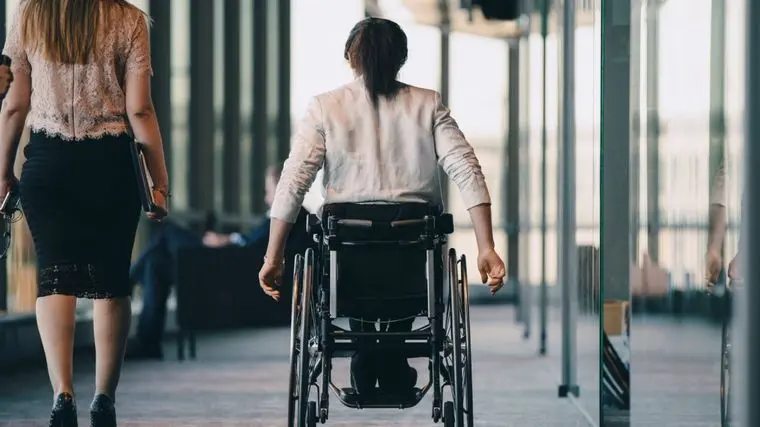The double discrimination that women with disabilities suffer
Being a woman and suffering from a disability means double discrimination. The dark side of disability exists and we must talk about it, society's rejection is evident and, although we have made a lot of progress, we still must continue fighting for respect for the dignity and rights of people with disabilities.

In the face of disability, there are usually two aptitudes: pity and, therefore, overprotection, which occurs to a greater extent in women, as part of the ideology of society in general of being the “weaker sex” and, on the other, rejection and discrimination. Both one ability and the other should be eliminated. Giving disability a chance is not easy, neither the regulations, nor the bonuses, aid, etc. They will be of no use until we banish prejudice and start with education, we have the rules, now we have to take action.
Women and girls with disabilities, the most vulnerable
The Convention on the Rights of Persons with Disabilities recognizes that women and girls who suffer from disabilities are at a worse starting point, as they are subject to multiple forms of discrimination. Among the objectives of the 2030 Agenda is to achieve equality between women and men and empower all women and girls. Women with disabilities face double discrimination that arises from the intersection of two factors: gender and disability.
The discrimination that women in this group face is a systematic aggravating factor. It limits our access to education, employment, and increases our vulnerability to violence and abuse. One of the most common forms of discrimination that we suffer, in addition to the lack of physical accessibility in public and private spaces, is labor exclusion.
We often have fewer employment opportunities. We also have a significantly higher unemployment rate than non-disabled people. This limits our economic independence and our ability to contribute to society. Throughout this article we will tell you what double discrimination against women with disabilities in their lives consists of. We will also provide the keys to remedy it. Remember that to have a better world, it is necessary for us all to work together. Keep reading!
How does double discrimination affect women with disabilities?
Double discrimination has multiple negative effects on our lives. We tell you some of the main effects:
- Limitations in access to education: we may face barriers in accessing education due to lack of physical accessibility, lack of training of educational personnel, and lack of resources. This can limit our learning and development opportunities, reduce employment prospects, and limit full participation in society.
- Limitations in access to health care: We often have to deal with barriers to accessing appropriate health services due to lack of accessibility, lack of training of medical staff on disability, or refusal of health care providers to treat them. This can lead to lack of medical care and exclusion from prevention and treatment programs.
- Greater vulnerability to violence and abuse: We are also more vulnerable to violence and abuse due to its double stigma. Unfortunately, we may experience increased victimization due to our disability from caregivers or care providers. Additionally, we often have less access to support and protection resources.
- Limitations on access to employment: Another limitation is that we are excluded from working life due to physical barriers, such as lack of accessibility of transport and work facilities, or social barriers, such as discrimination and stigma. This results in a significantly higher unemployment rate than that of people without disabilities. This limits our economic independence and ability to contribute to society.
How can women confront this double discrimination?
- Ensure physical accessibility of educational, medical, and workplace facilities, including ramps, accessible restrooms, and assistive technologies.
- Promote training of medical personnel and other service providers on the specific needs of people with disabilities, including women with disabilities.
- Promote gender equality through policies and programs that promote the active participation of women in society and the elimination of gender stereotypes that contribute to double discrimination of women with disabilities.
- Strengthen the protection of women with disabilities against violence and abuse. As? Through the implementation of specific laws and policies that consider their unique needs and experiences.
- Guarantee access to employment and education opportunities through inclusion policies. In this way, equal opportunities and access to training and skills development are promoted.
Likewise, it is important to involve women with disabilities themselves in decision-making. Likewise, policy implementation is also imperative, as we are the experts on our own needs and experiences.
Likewise, it is vital to adopt a comprehensive approach that addresses the physical and social barriers that contribute to exclusion. Furthermore, it is vital to promote gender equality and strengthen protection against violence and abuse. Only through a collective and collaborative approach can the rights and inclusion of women with disabilities be guaranteed.
Work is a basic element in people's lives. Having the possibility of having a fair and remunerated job strengthens the freedom and autonomy of human beings. Furthermore, every human being needs to belong to a group and a common cause that is worth fighting for. It is relevant to take into account that the ability to dignify the person through work is accentuated in groups with special abilities. This is because we are capable of improving our human capabilities and having our own self-perception of ourselves.

 IHRO NEWS
IHRO NEWS